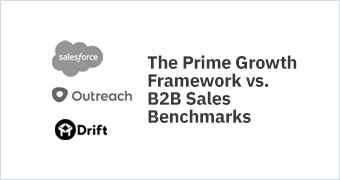The Prime Growth Framework for Small Business Suppliers
Identify the small businesses currently most likely to be growth motivated and receptive to new solutions, understand their current growth priorities, and effectively engage with them through value propositions that support those priorities.
The Prime Growth Framework has provided industry-leading results for Fortune 500 and emerging growth companies, and has been featured in Bloomberg and Harvard’s Data-Smart City Solutions.
CASE STUDIES

600+ new customers
Waste Management uses the Prime Growth Framework for Suppliers to increase small business customer acquisition and visibility into total addressable SMB market.
Over $1M USD lifetime value
Total lifetime value of new customers Waste Management gained through the Prime Growth Framework.
10x ROI
Waste Management’s return on investment using the Prime Growth Framework.
View the full Waste Management case study +

470 new customers
The company uses the Prime Growth Framework for Suppliers to increase small business customer acquisition.
3% lead-to-deal conversion
The company achieved 3% lead-to-deal conversion rates with their campaigns using the Prime Growth Framework, 4x the average of the 0.78% conversion for B2B sales leads based on Salesforce’s B2B Sales Benchmarks.
78% email open rate
The company achieved email open rates 3x higher using the Prime Growth Framework than their other SMB outreach campaigns.
View the full Fortune 500 case study +

4x higher conversion
With average lead-to-deal conversion rates of 3%, the Prime Growth Framework has 4x higher conversion than the average B2B sales lead (0.78%), 3x paid search (1%), and 15x lead lists (0.02%), according to Salesforce’s B2B Sales Benchmarks.
125% higher response
Email campaigns using Prime Growth average 125% higher response rates than industry benchmarks for outreach campaigns considered successful, based on benchmarks from Drift and Close.io.
3x higher call reach
Campaigns using the Prime Growth Framework achieved 3x higher call reach than industry benchmarks.
View the full B2B Benchmarks case study +
How it works
Through a proprietary combination of machine analysis and human analytics, we use Prime Growth Classification to continually identify current new (pre-opening) & high growth (expansion stage) firms throughout the US, and group them into five segments based on their current growth priorities.
Overview
1. Prime Growth Classification
2. The Prime Growth Briefing
3. Value Proposition Alignment
6. Deliverables
7. Pilot process
Gain a powerful new perspective
Prime Growth Classification
At the core of the framework is Prime Growth Classification, a growth-based classification standard for the small business sector developed by SMB Intelligence in 2018.
Growth-based classification uses development stage, growth format and growth scale to categorize firms rather than traditional small business segmentation. The purpose of the standard is to identify current prime growth firms and segment them by their current growth priorities.
Prime growth firms are independents or small chains, that are employers, with a commercial location(s), currently at a seed (new, pre-opening) or expansion (planning to add locations) development stage.
Growth priorities are the big picture context of an owner’s current growth plans – the format and scale of growth they are currently working to accomplish.
Why this matters
Most small business owners are not motivated by growth1 and the vast majority are not receptive to new solutions2.
Prime growth firms are the small businesses most likely to be motivated3 and receptive4. When you can identify prime growth firms and determine their current growth priorities, you can more effectively deliver relevant, timely and highly targeted value propositions, to the small businesses most likely to be receptive to them.
Traditional small business segmentation does not provide the ability to identify prime growth firms or their growth priorities, as the key indicators are current development stage, growth format, and growth scale5.
Learn more about Prime Growth Classification
1. Only 24% of owners report wanting their firm to be “as large as possible”, and more than 50% of owners cite lifestyle benefits such as “flexibility over schedule” or “be my own boss” as a primary reason for starting their firm. Pugsley, Benjamin Wild and Erik Hurst. “What Do Small Businesses Do?”, Brookings Papers On Economic Activity, Fall 2011. Available online. Only 33% of owners say their primary goal is to grow. The Hartford. “2015 Small Business Success Study”, 2015. Available online. 2. Waters, Steve. “Why The Vast Majority of Small Businesses Are Not Receptive to New Solutions”, SMB Intelligence, May 2018. Available online.. 3. Waters, Steve. “Most Small Business Owners are Motivated by Lifestyle – Not Growth”, SMB Intelligence, May 2018. Available online. 4. Waters, Steve. “Identifying the Small Businesses Most Receptive to New Solutions”, SMB Intelligence, May 2018. Available online. 5.Waters, Steve. “Growth-based Classification vs. Traditional Small Business Segmentation”, SMB Intelligence, May 2018. Available online.

Nearly 200,000 small businesses exist in NYC alone. Which are currently likely to be growth-motivated and receptive to your solutions?
Continually identify current prime growth small businesses
The Prime Growth Briefing
Published every two weeks in CSV format, The Prime Growth Briefing is a powerful dataset that identifies current prime growth small businesses in retail, services, healthcare, restaurant / hospitality, groups them into seven segments based on their current growth priorities, and provides deep insight into their current status.
SMB Intelligence uses proprietary open-source intelligence (OSINT) methods applied through a combination of machine analysis and human analytics.
We continually monitor over 30,000 real estate, editorial, public government data, social media and other sources to track planned growth activity in the small business sector.
Why this matters
Which firms are currently considered prime growth continually changes, as the sector churns with new firms entering, failed firms exiting and surviving firms moving through development stages.
Traditional small business datasets and segmentation does not provide insight into prime growth firms, growth priorities, or growth timing6.
Number of firms identified
The quantity of prime growth firms / establishments identified averages 15,000 annually. Monthly volume varies with sector conditions / activity.
Data Validation
Published every two weeks, the Prime Growth Briefing is the most current and accurate small business dataset available. We take extensive steps to ensure the veracity of the data we provide, and to present it to clients in a transparent manner. We use both internal and third-party validation tools, and all contact information is accompanied by validation status.
View the data points included in the Briefing.
6.Waters, Steve. “Growth-based Classification vs. Traditional Small Business Segmentation”, SMB Intelligence, May 2018. Available online.
More effectively align your value to prospect’s current priorities
Value alignment
The Prime Growth Briefing groups prime growth firms into seven segments based on their current growth priorities. Growth priorities refer to the big picture context of an owner’s current growth plans – the format and scale of growth they are currently working to accomplish.
This insight enables your team to align the value of your solutions to best support the current growth priorities of owners in each segment, making your value proposition more relevant, timely and compelling.
The Segments
1. Seed-NewFirm – a new owner currently planning to open a single location business.
2. Seed-Encore – an owner with previous entrepreneurial experience currently planning to open a single location business.
3. Expansion-Initial – a single location business currently planning to expand by opening a second location
4. Expansion-Emerge – a small emerging chain with 3-10 locations currently planning to add a location
5. Expansion-Advance – small advanced chain with 10-19 locations currently planning to add a location
6. Expansion-Velocity – small chain that is currently planning to add multiple locations at once
7. Expansion-Relocation – a small business that is planning to expand by relocating
Why this matters
Owners live in the moment7 and want solutions to current priorities, not generalized value8.

Boucherie, the latest expansion from restaurant collective The Group in NYC.
Deliverables
Datasets
The Prime Growth Briefing
The Briefing is published every two weeks and delivered in CSV format via email.
View the data points.
Consulting
Value alignment
Upon request we can review your value proposition and messaging to ensure they support the growth priorities of each segment. Consulting is delivered via email & phone.
Get started
